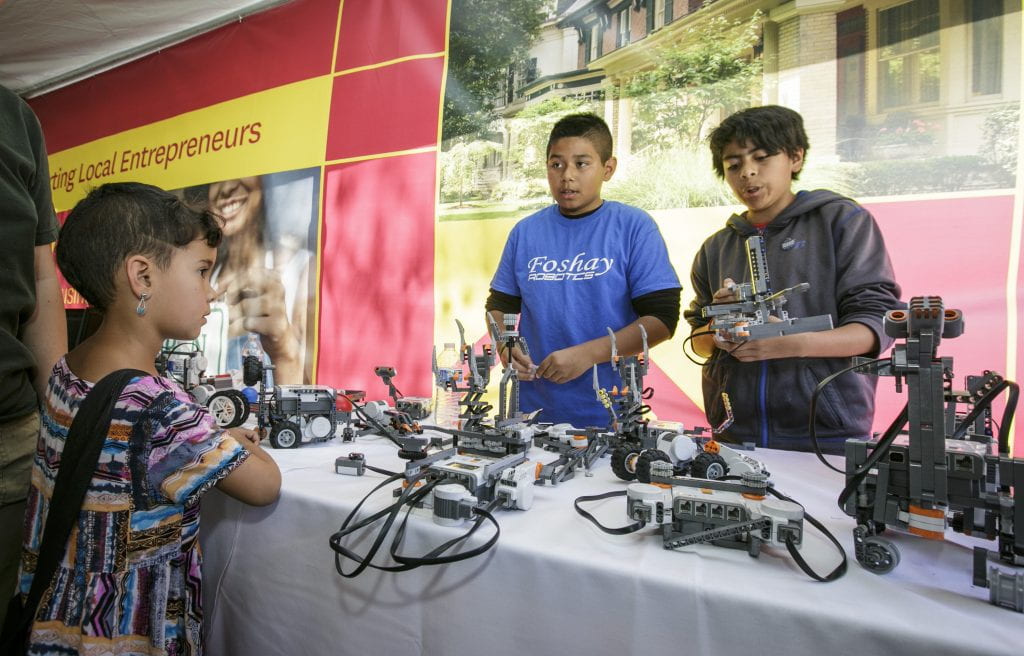For the Foshay Learning Center’s Team 597 Wolverines, it was a suspenseful moment. Which high school team would win the prized Chairman’s Award at the FIRST Robotics International Competition in St. Louis?
Bob Tuttle, FIRST’s co-chair of the board of directors, addressed the audience and talked about the accomplishments of the Wolverines. (FIRST refers to For Inspiration and Recognition of Science and Technology.)
“You all did a great job, but there is one team that is particularly special in this program,” he said. “They are the role models and change agents reaching out and transforming whole communities to show through their actions the lessons of team work, gracious professionalism and all the good life lessons FIRST is all about.
Jason Mares, a junior at Foshay, was confident that the school’s team would win the competition. After all, their presentation blew away the panel of judges. But then he looked around and felt uncertain. There were 59 other robotics teams from around the world in the competition. He decided it ultimately didn’t matter. If his team lost, it would simply come back next year, better and stronger, to win it.
Seconds later, Mares and 12 of his teammates heard their team name called, and they all ran up on stage to claim their trophy.
“That moment was just complete shock,” Mares said.
Enjoying the ride
For the South Los Angeles robotics team, it’s been quite the ride.
Math teacher Darryl Newhouse, the team’s mentor and coach, co-founded the program at Foshay in 2001. In 2003, the school held its first robotics class and in 2007, the class was expanded to the middle school.
What Newhouse lacked in robotics experience, he compensated with ingenuity.
“It’s just like anything else; if you don’t know, you just go to the World Wide Web,” Newhouse said. “You get a manual and you get enthusiastic kids. It was a fun journey.”
Resources were short and, in the beginning, much of the funding came from his own pocket as he maxed out credit cards. Someone put him in contact with Raytheon, which in turn asked, “What do you guys need to keep your program afloat?” Raytheon gave the team $6,000 that year, Newhouse said.
USC’s Good Neighbor Campaign and the USC Viterbi School of Engineering have been instrumental with their support of the program, Newhouse said. Their machine shop, and machinist Gary Kuepper in particular, provides services and advice, and USC Viterbi students, many of whom are Foshay graduates, provide help with design and construction of the robots.
“What we try to do is give kids at least a little bit of experience in machining, how to cut parts — that kind of thing,” Newhouse said. “That way when they are in the machine shop, they understand how to be safe.”
Each year, the team averages about 40 students, and if you count the middle school students, there are 70 pupils on the team. Although the robots the high school students work on are large, they are not big enough to have 40 people working on them. So the work is divided.
Some students work on cutting the chassis, others focus on the frame or the electronics and fundraising. They are organized into four sub-teams: public relations, the design and build team, the safety team and the Chairman Awards team, which focuses on preparing presentations and answering questions from the competition’s judges.
Dreams of the future
Team co-captain Ana Hernandez has been a member of the robotics team since middle school and proudly points out how half the team is made up of girls. She is a 2015 winner of the Award for Aspirations in Computing from the National Center for Women & Information Technology. The award recognizes young women for their outstanding aptitude and interest in computing, proven leadership ability, academic performance and plans for post-secondary education.
She’s headed off to Woodbury University on a scholarship to major in media technology and minor in video game design.
“I grew up with video games and trying to make an educational video game that is also fun for students is a challenge,” she said. “I want to think outside the box and design games that are educational and innovative. I really want to get in touch with the students. My dream would be to start my own gaming company.”
While part of the team, her favorite activities included doing robot demos and participating in numerous competitions. She has many fond memories of traveling with the team, working on numerous projects and interacting with the community at large.
“Last year we went to New York and that was the most fun I ever had,” she said. “We competed and won an award. We all got closer. It became apparent to us that we weren’t just a team. We were a family. This is a family that is not going to turn anyone away. Everyone has a place.”
By Ana Beatriz Cholo
